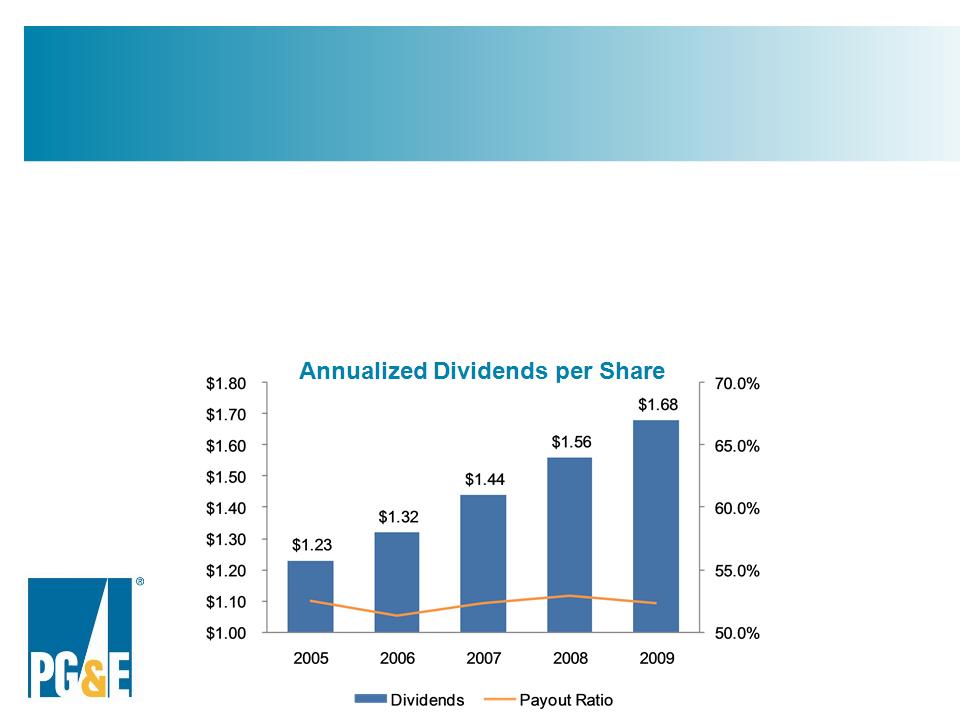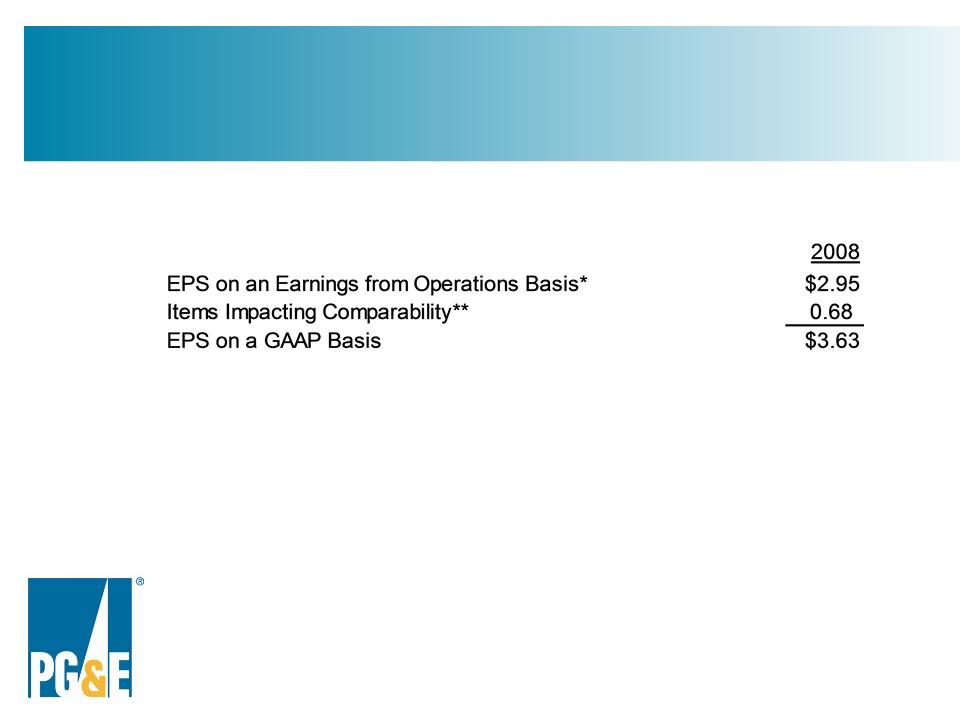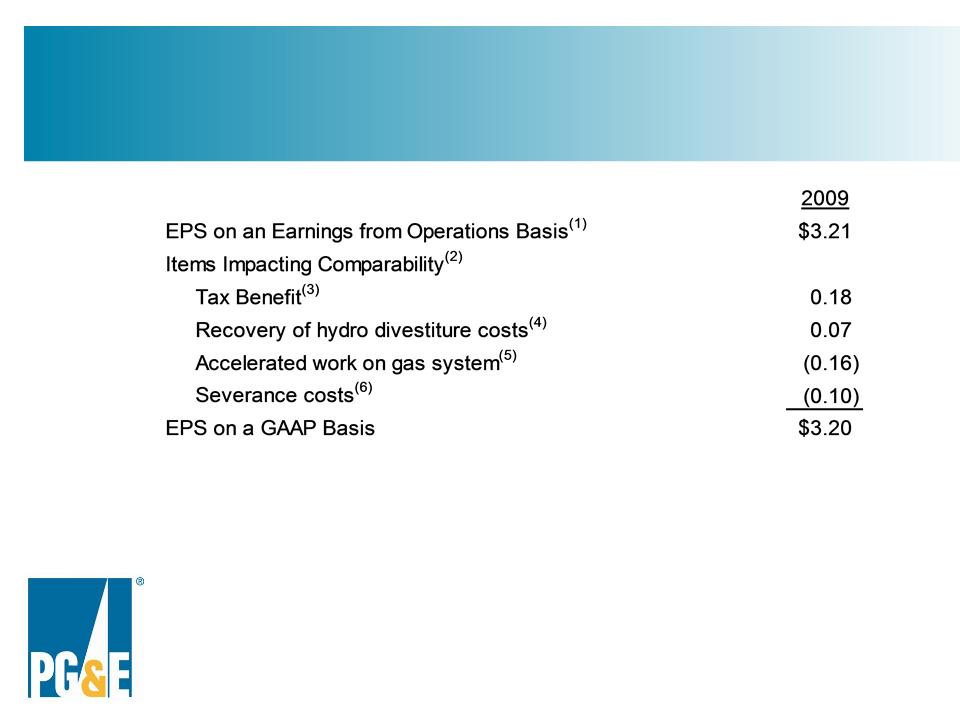This presentation contains management’s guidance for PG&E Corporation’s 2010 and 2011 earnings per share from operations. These statements and
projections, as well as the underlying assumptions, are forward-looking statements that are based on current expectations which management believes are
reasonable. These statements and assumptions are necessarily subject to various risks and uncertainties, the realization or resolution of which may be outside
of management's control. Actual results may differ materially. Factors that could cause actual results to differ materially include:
• the Utility’s ability to efficiently manage capital expenditures and its operating and maintenance expenses within authorized levels;
• the outcome of pending and future regulatory proceedings and whether the Utility is able to timely recover its costs through rates;
• the adequacy and price of electricity and natural gas supplies and whether the new day-ahead, hour-ahead, and realtime wholesale electricity markets
established by the California Independent System Operator (“CAISO”) will continue to function effectively, the extent to which the Utility can manage and respond
to the volatility of electricity and natural gas prices, and the ability of the Utility and its counterparties to post or return collateral;
• explosions, fires, accidents, mechanical breakdowns, the disruption of information technology and systems, and similar events that may occur while operating
and maintaining an electric and natural gas system in a large service territory with varying geographic conditions that can cause unplanned outages, reduce
generating output, damage the Utility’s assets or operations, subject the Utility to third-party claims for property damage or personal injury, or result in the
imposition of civil, criminal, or regulatory fines or penalties on the Utility;
• the impact of storms, earthquakes, floods, drought, wildfires, disease, and similar natural disasters, or acts of terrorism or vandalism, that affect customer
demand or that damage or disrupt the facilities, operations, or information technology and systems owned by the Utility, its customers, or third parties on which
the Utility relies;
• the potential impacts of climate change on the Utility’s electricity and natural gas businesses;
• changes in customer demand for electricity and natural gas resulting from unanticipated population growth or decline, general economic and financial market
conditions, changes in technology that include the development of alternative technologies that enable customers to increase their reliance on self-generation, or
other reasons;
• the occurrence of unplanned outages at the Utility’s two nuclear generating units at Diablo Canyon, the availability of nuclear fuel, the outcome of the Utility’s
application to renew the operating licenses for Diablo Canyon, and potential changes in laws or regulations promulgated by the NRC or environmental agencies
with respect to the storage of spent nuclear fuel, security, safety, or other matters associated with the operations at Diablo Canyon;
• whether the Utility earns incentive revenues or incurs obligations under incentive ratemaking mechanisms, such as the CPUC’s incentive ratemaking
mechanism relating to energy savings achieved through implementation of the utilities’ customer energy efficiency programs;
• the impact of federal or state laws or regulations, or their interpretation, on energy policy and the regulation of utilities and their holding companies;
• whether the Utility can successfully implement its program to install advanced meters for its electric and natural gas customers and integrate the new meters
with its customer billing and other systems, the outcome of the independent investigation ordered by the CPUC and the California Legislature into customer
concerns about the new meters, and the ability of the Utility to implement various rate changes including “dynamic pricing” by offering electric rates that can
vary with the customer’s time of use and are more closely aligned with wholesale electricity prices;
• how the CPUC interprets and enforces the financial and other conditions imposed on PG&E Corporation when it became the Utility’s holding company and the
extent to which the interpretation or enforcement of these conditions has a material impact on PG&E Corporation;
• the outcome of litigation, including litigation involving the application of various California wage and hour laws, and the extent to which PG&E Corporation or
the Utility incurs costs and liabilities in connection with litigation that are not recoverable through rates, from insurance, or from other third parties;
• the ability of PG&E Corporation, the Utility, and counterparties to access capital markets and other sources of credit in a timely manner on acceptable terms;
• the impact of environmental laws and regulations and the costs of compliance and remediation;
• the loss of customers due to various forms of bypass and competition, including municipalization of the Utility’s electric distribution facilities, increasing levels
of “direct access” by which consumers procure electricity from alternative energy providers, and implementation of “community choice aggregation,” which
permits cities and counties to purchase and sell electricity for their local residents and businesses;
• the outcome of federal or state tax audits and the impact of changes in federal or state tax laws, policies, or regulations; and
• other factors and risks discussed in PG&E Corporation and Pacific Gas and Electric Company’s 2009 Annual Report on Form 10-K and other reports filed with
the Securities and Exchange Commission.
Cautionary Language Regarding
Forward-Looking Statements
2




















